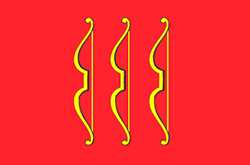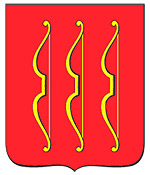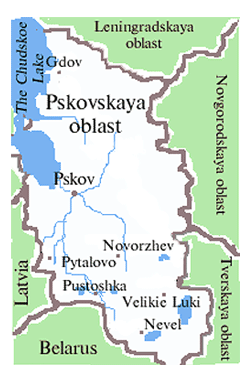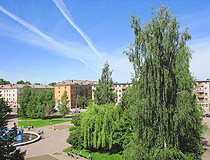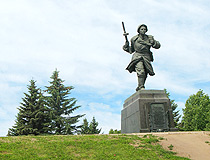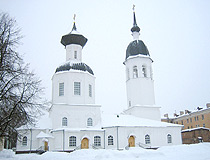Velikiye Luki - Overview
Velikiye Luki or Velikie Luki is a city in Russia located in the Pskov region, 474 km west of Moscow. It is a large trade and industrial center of the southern part of the region, important cultural and educational center.
The population of Velikiye Luki is about 90,100 (2022), the area - 60 sq. km.
The phone code - +7 81153, the postal codes - 182100-182115.
History of Velikiye Luki
Velikiye Luki is one of the oldest cities in Russia. The first time it was mentioned in the Novgorod chronicle as a town called Luki in 1166. Since the 12th century, it was part of the Novgorod principality, built as a fortress on the way to Novgorod and Pskov in 1211. In 1406, Luki was called Velikiye (Great).
From 1478, when Ivan III conquered Novgorod, the town like all the Novgorod land became part of the Moscow principality. By the end of the 15th century, Velikiye Luki was one of the fortresses in a line of defense between Smolensk and Pskov, it was an important center of concentration of Russian troops.
During the Livonian War, the headquarters of the Russian Tsar Ivan the Terrible was located in this town (from 1558). In 1580, the fortress was captured by the Polish and Lithuanian troops of the King Stephen Bathory. In 1583, according to Yam-Zapolsky peace treaty, the town was returned to the Russian kingdom.
More Historical Facts…
In the Time of Troubles, the town was again in the center of the fighting. In 1611, it was completely destroyed; restoration work began in 1619. Velikiye Luki was visited by many historical figures: Tsar Ivan IV the Terrible, the Emperor Peter I the Great, Empress Catherine II the Great, Emperors Alexander I and Nicholas I, the last Russian Empress Alexandra Feodorovna.
In 1724, Peter I signed a decree declaring Velikiye Luki a port town. During the Russian-French War of 1812, it was a large base of the Russian army, protecting the approaches to St. Petersburg and Pskov. In 1901, the railway Moscow-Rzhev-Riga-Vindava passed through the town.
Throughout its history, Velikiye Luki was destroyed several times, but it was actually razed to the ground during World War II. The battle for Velikiye Luki was so furious that the city was called “small Stalingrad”. After the liberation, 3083 out of 3391 buildings were destroyed or burned. In October 2008, Velikiye Luki received the title “The City of Military Glory”.
Streets of Velikiye Luki
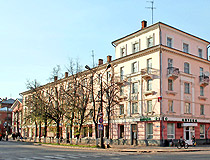
Intersection in Velikiye Luki
Author: Alexandr Mav

Velikiye Luki architecture
Author: Alexandr Mav
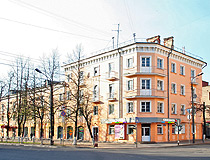
Velikiye Luki street
Author: Alexandr Mav
Velikiye Luki - Features
Velikiye Luki is a beautiful, modern city with a developed industry, located at the crossroads of the major roads of Western part of Russia. City Day is celebrated in July.
It is located close to the federal highway M9 “Baltics”. There is a railway station; trains to Moscow, St. Petersburg, Murmansk, Riga and other cities are available. The railway trip from Moscow takes about 9 hours. Velikiye Luki has no airport.
The climate is temperate continental with long, snowy winters with thaws and moderately warm, often rainy summers. The average temperature in February - minus 6 degrees Celsius, in July - plus 18 degrees Celsius.
Velikiye Luki was almost completely destroyed during the Second World War. That is why there are no monuments of medieval architecture in the city.
Velikiye Luki views
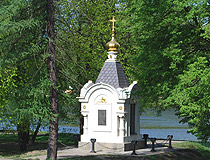
Chapel of Alexander Nevsky in Velikiye Luki
Author: Yuriy Rudyy
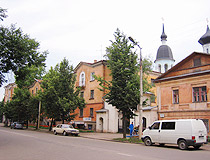
On the street in Velikiye Luki
Author: Yuriy Rudyy

Obelisk of Glory in Velikiye Luki
Author: Yuriy Rudyy
Attractions of Velikiye Luki
There are high (21 meters) ramparts of an ancient fortress near the Lovati River. Here you can also find a monument dedicated to the Second World War (Obelisk of Glory) and T-34 tank. Velikiye Luki is well seen from this point.
Lenin Square is considered the main square of the city. There is a music school named after M.P.Musorgsky there and “Yubileinaya” hotel. On the south side there is a park with a fountain.
Lieutenant Schmidt Embankment begins on Lenin Square. Along the Lovati River you can see numerous flower beds that adorn the embankment and make the locals proud of their city.
If you walk down Lenin Avenue, the next square is the one named after K.K.Rokossovsky, the famous Soviet commander who spent his childhood in Velikiye Luki. There is a monument to Rokossovsky on this square and a fountain called “Stone Flower” - the pride of Velikiye Luki. Opposite the fountain you can see a drama theater.
The square is connected with Alexander Matrosov, the Hero of the Soviet Union. His remains are buried here. The famous sculptor Ye.V.Vuchetich created the monument to Alexander Matrosov standing there.
Other sights:
- Velikiye Luki Museum of Local Lore (Lizy Chaykinoy Street, 14),
- Velikiye Luki Drama Theater (Oktyabrskiy Avenue, 28/13),
- Movie theater “Rodina” (Lizy Chaykinoy Street, 11/19),
- Velikiye Luki Philharmonic (Polovskaya Street, 8,),
- Kazan Church (1821) (Pushkinskaya Street, 2),
- Ascension Cathedral (1752) (Uritskogo Street, 4).


